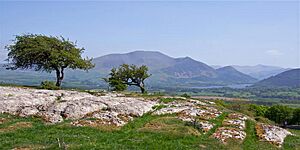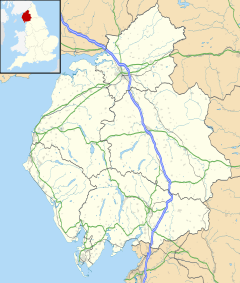Blindcrake facts for kids
Quick facts for kids Blindcrake |
|
|---|---|
 Clints Crag above Blindcrake |
|
| Population | 348 (2011 Census) |
| OS grid reference | NY 14830 34771 |
| Civil parish |
|
| Unitary authority |
|
| Ceremonial county | |
| Region | |
| Country | England |
| Sovereign state | United Kingdom |
| Post town | COCKERMOUTH |
| Postcode district | CA13 |
| Dialling code | 01900 016973 017687 |
| Police | Cumbria |
| Fire | Cumbria |
| Ambulance | North West |
| EU Parliament | North West England |
| UK Parliament |
|
Blindcrake is a small village in the beautiful Lake District National Park in Cumbria, England. It's part of a larger area called the Isel Valley. In 2011, about 348 people lived here. The area includes Blindcrake village itself, plus the smaller places of Redmain, Isel, and Sunderland.
Blindcrake village is special because it's a "conservation area." This means its old-fashioned layout, with fields shaped like strips, is protected. Experts say it's the best example of this kind of old field pattern in the whole Lake District!
Contents
How Blindcrake is Governed
Blindcrake is part of the Copeland area for the UK Parliament. This means people living here vote for a Member of Parliament (MP) to represent them in the government. The current MP is Trudy Harrison.
For local decisions, Blindcrake has its own group called the Blindcrake Parish Council. This council helps manage local services and looks after the village. It's also part of the larger Cumberland area, which handles bigger local issues.
What's in a Name?
The name Blindcrake is very old. It was first written down in 1246 as Blenckrayk. The name comes from an ancient language called Brittonic.
The first part, Blenc, usually means "summit" or "top of a hill." The second part, crayk, means "a crag" or "a big, noticeable rock." So, the name probably means something like "hilltop crag."
A Look Back in Time
Blindcrake has a long history! People might have lived here since the Iron Age, which was thousands of years ago. You can still see signs of old field systems from the Middle Ages in the village.
Most of the houses in Blindcrake were built in the 1700s. They are spread out along the main street. Today, there are still four working farms in the village. Blindcrake also has a village green and a smaller green with a very old well. This well is so important that it's a "Grade II listed" building, meaning it's protected.
The village often wins awards for its beauty, like in the Cumbria in Bloom competition. It even won a special award in 1999 for being a "Top Beauty Spot in the British Isles."
The local church, St Michael and All Angels, is from the 11th century. It's located in Isel, a short distance from Blindcrake. An old school, Isel School, served the area since 1674. It's now a private home. The village pub, the Ghyll Yeat Inn, used to be a toll house. It closed as a pub in 2000 and is now also a private home.
Isel Hall and May Moore
Isel Hall is a very old and important house near Blindcrake. It stands on a hill overlooking the River Derwent. The oldest part of the hall is a strong tower built around 1400. It was made to protect against raids. Different families have lived in Isel Hall for centuries.
A special person named May Moore used to work at Isel Hall as a parlourmaid in the 1920s. She started working there when she was just 13! She even drove the family car to collect supplies when she was only 14. Later, she worked for the famous author Beatrix Potter, helping her with chores and even cutting her hair.
May Moore returned to Blindcrake later in life. She spent 17 years working at a local clothing factory. After she retired, she helped as a guide at Isel Hall, sharing amazing stories about what life was like in the early 1900s. The village celebrated her 90th birthday in 1997. She passed away in 2003 at the age of 96.
Blindcrake has seven houses that are "Grade II listed," meaning they are historically important. Many were built in the early 1700s. One old building used to be a bacon-curing room downstairs and a meeting room for Methodists upstairs. It later became a chapel and is now a private home. The village hall is also in this row of old buildings.
Exploring Blindcrake's Surroundings
Blindcrake is about 4 kilometers (2.5 miles) northeast of Cockermouth. It's also about 12 kilometers (7.5 miles) from Keswick. The village sits on a high spot, offering amazing views of the Skiddaw and Buttermere mountains in the Lake District.
Wildlife in the Area
The countryside around Blindcrake is full of amazing wildlife! You can spot many different birds, like the Eurasian oystercatcher, Eurasian curlew, and Eurasian skylark. In fact, 94 different bird species have been seen here!
There are also many types of butterflies, including some rare ones like the pearl-bordered fritillary. This is because the area has a mix of hills, woodlands, and meadows. You might also see red squirrels, roe deer, foxes, and badgers in the woods.
 |
Millstone Moor | Moota | Bothel |  |
| Redmain | Bewaldeth | |||
| Cockermouth | Setmurthy | Isel |
Walking Adventures
If you love walking, Blindcrake is a great place to start!
Clints Crags
About a mile from the village, you can find Clints Crags. This area is special because of its unique limestone rocks. From the top, you get incredible views across the entire Lake District. You can see mountains from the Ennerdale Fells all the way to the Helvellyn range. A famous walker named Alfred Wainwright even wrote about climbing Clints Crags in one of his books!
The Allerdale Ramble
Another walking path, called the Allerdale Ramble, goes right through the Blindcrake area. It follows the north side of the River Derwent towards Bassenthwaite Lake.
Weather in the Isel Valley
The Isel Valley, where Blindcrake is located, has a mild climate like most of the UK. However, it's one of the driest and sunniest parts of the Lake District.
Summers are usually warm with some rain. Late spring and mid-summer are often the driest times of the year. Winters can be mild and wet. But because of the hills, very cold winters can bring lower temperatures and more snow here than in other nearby areas.
The valley is sheltered, which can sometimes lead to fog in winter mornings while it's clear higher up. In summer, the sunny slopes and sheltered valley can get warmer than surrounding areas.
| Climate data for Isel valley, Lake District | |||||||||||||
|---|---|---|---|---|---|---|---|---|---|---|---|---|---|
| Month | Jan | Feb | Mar | Apr | May | Jun | Jul | Aug | Sep | Oct | Nov | Dec | Year |
| Record high °C (°F) | 15 (59) |
18 (64) |
21 (70) |
26 (79) |
28 (82) |
30 (86) |
31 (88) |
30 (86) |
29 (84) |
25 (77) |
20 (68) |
16 (61) |
31 (88) |
| Mean daily maximum °C (°F) | 3.5 (38.3) |
4.5 (40.1) |
9 (48) |
12 (54) |
16 (61) |
18 (64) |
20 (68) |
19 (66) |
17 (63) |
13 (55) |
8 (46) |
4.5 (40.1) |
12.0 (53.6) |
| Mean daily minimum °C (°F) | 0.5 (32.9) |
0.5 (32.9) |
2 (36) |
4 (39) |
7 (45) |
9 (48) |
12 (54) |
11 (52) |
9 (48) |
6 (43) |
4 (39) |
0.5 (32.9) |
5.5 (41.9) |
| Record low °C (°F) | −18 (0) |
−15 (5) |
−10 (14) |
−8 (18) |
−3 (27) |
1 (34) |
4 (39) |
3 (37) |
−1 (30) |
−9 (16) |
−11 (12) |
−15 (5) |
−18 (0) |
| Average precipitation mm (inches) | 96 (3.8) |
79 (3.1) |
90 (3.5) |
55 (2.2) |
61 (2.4) |
67 (2.6) |
72 (2.8) |
85 (3.3) |
108 (4.3) |
120 (4.7) |
118 (4.6) |
112 (4.4) |
1,063 (41.9) |
| Average snowy days | 10 | 8 | 8 | 4 | 1 | 0 | 0 | 0 | 0 | 1 | 4 | 9 | 45 |
| Mean monthly sunshine hours | 44 | 73 | 112 | 155 | 214 | 203 | 190 | 180 | 135 | 94 | 61 | 35 | 1,496 |


